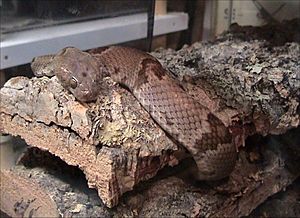Texas lyre snake facts for kids
Quick facts for kids Texas lyre snake |
|
|---|---|
 |
|
| Conservation status | |
| Scientific classification | |
| Genus: |
Trimorphodon
|
| Species: |
vilkinsonii
|
| Synonyms | |
|
|
The Texas lyre snake (Trimorphodon vilkinsonii) is a cool snake that lives in the southwestern United States and northern Mexico. It's a type of snake that has fangs in the back of its mouth and is only a little bit venomous. Don't worry, its venom isn't dangerous to humans! It belongs to a big group of snakes called Colubridae.
Contents
What's in a Name?
The second part of the snake's scientific name, vilkinsonii, is a special way to honor someone. It was named after an American nature lover named Edward Wilkinson. He was the first person to collect a specimen of this snake. He found it near the city of Chihuahua in Mexico.
Where Does It Live?
The Texas lyre snake can be found in the United States in a part of Texas called the Big Bend region. It also lives in southern New Mexico. In Mexico, you can find it in the northeastern part of the Chihuahua state.
Its Home and Habitat
This snake loves to live in dry, rocky places. Its favorite natural homes are deserts and areas with lots of rocks. It likes to hide among the stones and crevices.
What Does It Look Like?
The Texas lyre snake is a medium-sized snake. It can grow to be about 1 meter (or 39 inches) long, including its tail. Its body can be brown, tan, or gray. It has about 17 to 24 dark brown blotches, which are like big spots, down its back.
It has large eyes with pupils that look like thin lines, similar to a cat's eye. The name "lyre snake" comes from a special V-shaped pattern that many snakes in its group have on their heads. This pattern looks like a musical instrument called a lyre. However, this specific Texas lyre snake doesn't have that V-mark on its head.
Behavior and Diet
Texas lyre snakes are nocturnal, which means they are most active at night. During the day, they usually hide in cracks and spaces between rocks. When night comes, they come out to hunt for food.
They mainly eat lizards. But they also enjoy small rodents, frogs, bats, and birds. Their venom is not considered harmful to people. If their venom doesn't completely stop their prey, they can also squeeze and constrict their prey to catch it.
Conservation Status
For a while, the Texas lyre snake was listed as "Threatened" in Texas. This meant people were worried about its numbers. But in 2020, it was removed from that list.
Even though this snake is good at hiding and can be hard to find, it seems to be common in its habitat. A lot of the places where it lives are protected areas or private lands, which helps keep them safe.
Reproduction and Life Cycle
Texas lyre snakes are oviparous. This means that, like many other snakes, they lay eggs. A female snake usually lays about a dozen eggs in one clutch.


